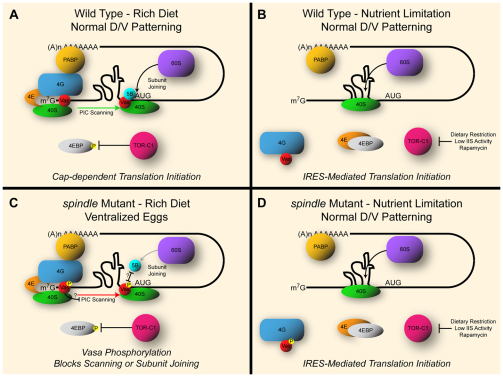Fig. 7.
A model of Vasa-independent grk translation. (A) When nutrients are abundant, cap-dependent translation predominates. Vasa helicase activity facilitates 43S PIC scanning of the 5′-UTR, allowing it to navigate secondary structures. Once an AUG codon is identified, Vasa–eIF5B interactions promote joining of the 60S subunit to form the 80S ribosome. (B) When nutrients are low, IIS is compromised or flies are fed the TOR-C1 inhibitor rapamycin, TOR activity falls and 4EBP is free to inhibit the cap-binding protein eIF4E. The resulting increase in free ribosomes favors IRES translation initiation of the localized grk transcript allowing oocytes to be patterned correctly, thereby preserving their viability for when nutrients are available again. (C) spindle-class mutants such as spn-BBU inhibit grk translation by phosphorylating Vasa in a checkpoint-dependent manner. This disrupts scanning of the 43S PIC and/or interactions with eIF5B (5B) and therefore subunit joining at the initiation AUG codon. In these conditions, grk cannot be translated and ventralized eggs result. (D) Reduced TOR activity in a spn-B mutant background permits grk translation independent of Vasa activity. Despite the inhibition of cap-dependent translation initiation resulting from Vasa phosphorylation and increased 4EBP activity, grk translation persists. We hypothesize that this is due to alternative translation initiation at an IRES in the grk 5′-UTR.

